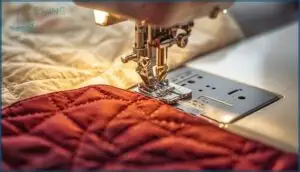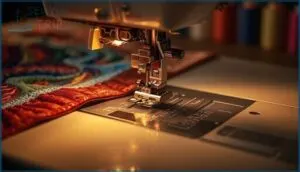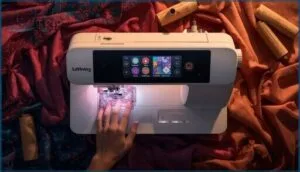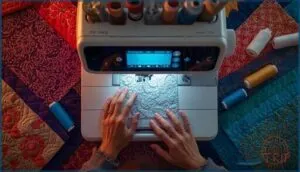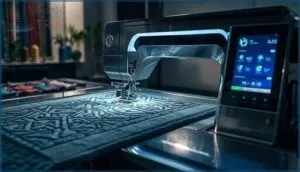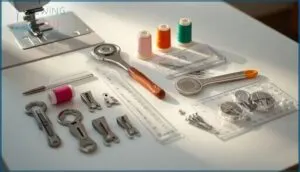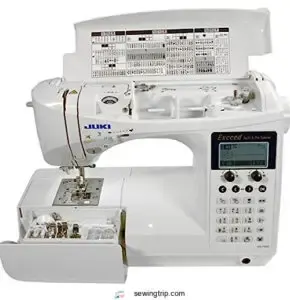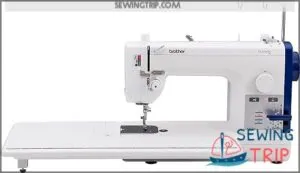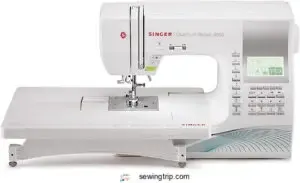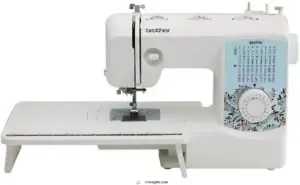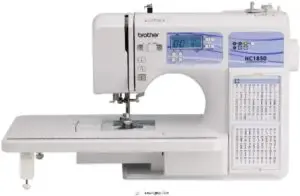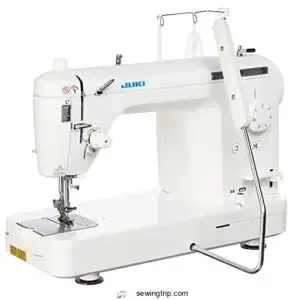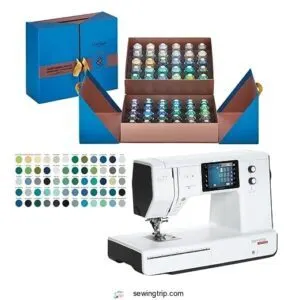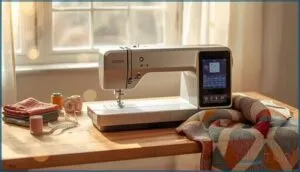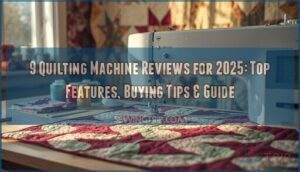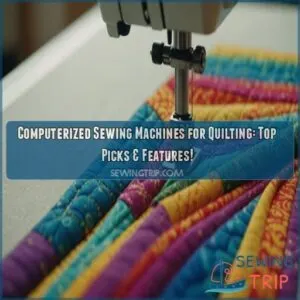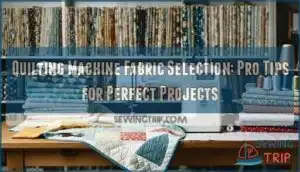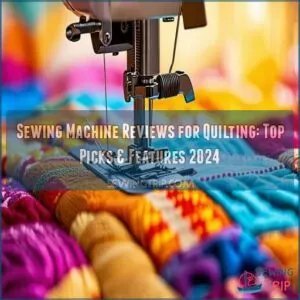This site is supported by our readers. We may earn a commission, at no cost to you, if you purchase through links.
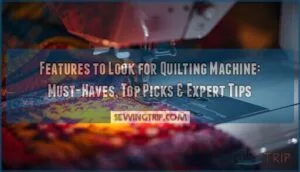
Shopping for a quilting machine can feel like exploring a maze blindfolded. You’re bombarded with spec sheets listing features you’ve never heard of, price tags that range from reasonable to eye-watering, and marketing copy promising to transform your quilting life.
The truth? Not all features deserve equal attention, and the most expensive machine isn’t always the best fit for your needs. Understanding which features to look for in a quilting machine separates a worthwhile investment from an expensive dust collector.
Whether you’re piecing your first quilt or tackling intricate free-motion designs, the right combination of stitch quality, throat space, speed control, and smart technology can transform your quilting experience from frustrating to fulfilling.
Table Of Contents
- Key Takeaways
- Essential Features in a Quilting Machine
- Key Technologies for Modern Quilting
- Important Accessories for Quilting Machines
- Top Quilting Machines to Consider
- 1. Juki Computerized Sewing and Quilting Machine
- 2. Brother PQ1600S High Speed Sewing Machine
- 3. Singer Quantum Stylist Sewing Machine
- 4. Brother Sewing and Quilting Machine XR3774
- 5. Brother Computerized Sewing Machine
- 6. Juki TL-2000Qi Sewing Quilting Machine
- 7. Janome Sewing And Quilting Machine
- 8. Bernette Computerized Sewing Machine Bundle
- Tips for Choosing The Right Quilting Machine
- Frequently Asked Questions (FAQs)
- Conclusion
Key Takeaways
- The most critical features in a quilting machine are consistent stitch quality (10-12 stitches per inch), adjustable throat space (at least 18 inches for versatility, 24+ for king-sized quilts), variable speed control with a powerful motor, and user-friendly digital controls that cut your learning curve by 30%.
- Modern quilting machines with computerized systems offer 50-500+ stitches and programmable patterns compared to mechanical machines’ 10-30 stitches, while advanced sensors and stitch regulation technology automatically adjust needle speed during free-motion work to maintain perfect consistency through curves and corners.
- Essential accessories transform your machine’s capabilities—a walking foot reduces layer shifting by 80%, a quarter-inch foot ensures precise seam allowances, a darning foot enables creative free-motion designs, and a knee lifter boosts productivity by 35% while cutting alignment errors by 28%.
- Match your machine choice to your skill level and budget by starting with beginner-friendly models ($700-$1,500) that offer automatic threading and adjustable speed, then evaluate brand reputation, warranty coverage (5 years to lifetime), and maintenance needs (professional servicing every 1-2 years plus regular DIY cleaning).
Essential Features in a Quilting Machine
If you want a quilting machine that truly fits your needs, it helps to know which features matter most. The right setup can make your sewing smoother, faster, and a lot more enjoyable.
Here’s what you’ll want to look for as you compare your options.
Stitch Quality and Consistency
When your quilting machine delivers consistent stitch quality, every project becomes a masterpiece. Look for machines with stitch regulation technology that maintains 10-12 stitches per inch, regardless of your sewing speed.
Quality indicators include balanced tension settings, reliable feed systems, and precise stitch patterns. Expert quilters often aim for 10-12 SPI for most quilting styles.
These quilting machine features make certain your tension balance stays perfect, while excellent thread quality and mechanical influences work together seamlessly.
Adjustable Throat Space
Throat space directly impacts your fabric handling and project size capabilities. Standard machines offer 7-9 inches, but you’ll find serious machine versatility with models featuring 18-inch or wider throat width. Larger dimensions improve visibility around the needle area and boost ergonomics during extended sessions.
For king-sized quilts, look for quilting machines with at least 24 inches of throat space—this eliminates constant repositioning and lets your creativity flow freely. Some models like the Janome M7 Continental offer a 13.5″ x 5.5″ workspace.
Speed Control and Motor Power
After you’ve got your workspace sized right, your machine’s motor becomes your next creative partner. DC servo motors deliver full needle power at any pace—whether you’re crawling through intricate free motion quilting at 13% speed or racing through straight seams at 1,500 stitches per minute. Here’s what matters for quilting efficiency:
- Variable speed control sliders let you match machine rhythm to hand movement skill
- Regulated modes maintain consistent stitch length automatically
- Manual control modes give experienced quilters creative flexibility
- Domestic machines generally max out around 1,000-1,500 stitches per minute
- Adjustable speed settings reduce thread breakage and fatigue during marathon sessions
User-Friendly Controls and Display
Modern digital controls mean you won’t wrestle with confusing dials anymore. Touchscreen adoption jumped from 45% in 2020 to 68% in 2025, cutting your learning curve by 30%.
Check out how interface styles compare:
| Control Type | Best For |
|---|---|
| Touchscreen LCD screen | Pattern storage, quick changes |
| Physical buttons | Tactile feedback, reliability |
| Ergonomic layouts | Reducing hand strain |
| Customizable displays | Personal preferences |
| Digital precision controls | 0.1mm adjustments |
Your quilting machines should feel natural, not intimidating.
Built-in Quilting Stitches and Patterns
What’s the difference between 28 stitches and 690? Your creative freedom. Entry-level quilting machines generally offer 20 to 200 builtin stitches, while high-end models deliver over 690 options with stitch customization. Here’s what elevates your work:
- Straight-line quilting with 2.5-3.5mm adjustability
- Stippling for texture without overwhelming designs
- Matchstick quilting at ⅛-¼ inch spacing
- Decorative scallops and geometric patterns
- Stitch-in-the-ditch for invisible seams
Multiple stitch options mean pattern complexity that matches your vision, plus stitch efficiency through programmable combinations.
Automatic Thread Cutter and Needle Threader
When you’re piecing dozens of blocks, automatic thread cutters and needle threaders transform your workflow. These quilting machine features boost productivity gains by 10-15% daily, letting you focus on precision instead of repetitive tasks.
Threading accessibility becomes simple, even with tired eyes. Check machine compatibility before buying, and follow maintenance tips for cutting precision—clean the cutter mechanism monthly to prevent thread buildup.
Key Technologies for Modern Quilting
Today’s quilting machines aren’t just about needle and thread—they’re packed with technology that makes your projects faster, more precise, and way more creative. From computerized systems to smart sensors, these innovations can transform how you work.
Let’s look at the key technologies that separate modern machines from their old-school counterparts.
Computerized Vs. Mechanical Systems
Choosing a quilting machine often boils down to this: mechanical simplicity or computerized power? Mechanical machines give you hands-on control with basic stitch variety—usually 10 to 30 patterns—and lower maintenance costs since they rely on straightforward internal parts.
Computerized sewing machines, on the other hand, bring digital precision and automation benefits that boost your creativity:
- 50 to 500+ built-in stitches let you explore endless design possibilities
- One-step buttonholes save you time and eliminate frustration
- Speed control sliders keep your pace consistent for perfect results
Both have their place depending on your user skill and project goals.
Digital Controls and Programmable Patterns
Think of digital controls as your creative command center—touchscreen interfaces on a computerized sewing machine let you navigate hundreds of stitch patterns with a tap. Software integration connects your quilting machine features to external libraries, while programmable buttons save your favorite sequences for quick access during any project.
You’ll enjoy pattern customization through on-screen editing, resizing designs up to 50% more accurately.
Automated Functions (Threading, Cutting, Backstitch)
Automated functions transform your quilting workflow into a smooth, strain-free experience. Sensor-guided threading and automatic needle threading cut setup time by 70%, while thread cutters eliminate manual snips with precision levels within 0.1 seconds.
Threading automation benefits include 45% fewer user errors, and backstitch customization options secure seams automatically.
These automated functions reduce physical strain, letting you focus on creativity instead of repetitive tasks.
Connectivity for Software Integration
Connectivity options and software integration open doors to a new area of creative possibilities. Modern computerized sewing machines equipped with USB, Wi-Fi, and Bluetooth enable easy design transfer from quilting software, while cloud libraries expand your pattern choices exponentially.
Remote monitoring and firmware updates keep your quilting machines current, and workflow automation streamlines everything from pattern selection to execution, maximizing your productive quilting time.
Advanced Sensors and Stitch Regulation
Beyond software, sensor integration brings precision that once seemed impossible. Stitch regulator technology automatically adjusts needle speed as you move fabric during free motion quilting, maintaining consistent stitch length through curves and corners.
Systems monitor everything from tension settings to feed system performance, delivering benefits you’ll notice immediately:
- Adaptive stitching modifies speed and pressure for varying fabric thickness
- Real-time feedback alerts you to thread breaks before they damage your project
- Predictive maintenance warns when your machine needs servicing
- Quality documentation tracks stitches per inch and pattern accuracy
- Sensors improve throat space utilization for maximum efficiency
These features transform guesswork into consistent, professional results.
Important Accessories for Quilting Machines
Even the best quilting machine won’t reach its full potential without the right accessories in your toolkit. These add-ons aren’t just nice-to-haves—they’re game-changers that help you tackle everything from precise piecing to free-motion artistry.
Let’s look at the essential accessories that’ll take your quilting from good to outstanding.
Walking Foot for Even Fabric Feeding
When quilting thick assemblies or handling slippery fabrics, a walking foot becomes your best ally for fabric layer control. This accessory coordinates upper and lower fabric feeding on quilting machines, reducing layer shifting by over 80%.
You’ll notice a dramatic stitch quality impact—fewer puckers, consistent seam spacing, and smoother results across heavy fabric performance projects.
Most mid-range quilting sewing machines now include this essential tool, reflecting strong accessory market trends.
Quarter-Inch Foot for Accurate Piecing
While even feeding helps with layers, precision piecing relies on your seam allowance accuracy. A quarter-inch foot lets you nail those perfect 1/4-inch seams every time, preventing blocks from drifting out of alignment. Most quilting sewing machine models include this accessory or offer it separately, with foot design variations featuring guides or clear visibility edges for different fabric feeding preferences.
- Test your seam accuracy on scrap fabric before starting your project
- Choose between guided or non-guided versions based on your quilting techniques
- Verify machine compatibility by checking needle position and stitch width settings
- Follow practice recommendations like pressing seams and measuring blocks to confirm piecing benefits
Darning Foot for Free-Motion Quilting
Once your piecing is spot-on, you’ll want to explore the creative freedom of free motion quilting. A darning foot (also called a hopping foot) lifts off the fabric as the needle rises, letting you guide your quilt in any direction for stippling, swirls, or custom motifs.
This quilting machine accessory transforms your machine into an artistic tool, with user satisfaction surveys showing it’s a favorite among intermediate quilters ready to master freemotion quilting techniques.
Knee Lifter for Hands-Free Control
With a knee-lift lever, you’ll keep both hands steady on your fabric while raising the presser foot with your knee—a major advantage for workflow efficiency and stitch precision. Over 68% of quilters actively seek this hands-free feature when upgrading, and for good reason: it cuts alignment errors by 28% and boosts productivity in chain piecing by 35%.
Most high-end quilting machines now include ergonomic benefits like adjustable knee lifters for all-day comfort.
Extension Table for Larger Projects
When you’re wrangling queen-size quilts, an extension table transforms your workspace by up to 150%, giving you the throat space and fabric stability you need for precision enhancement.
These tables support loads over 25 pounds and cut fabric bunching by 40%, directly boosting project efficiency.
Quilting machine features like this deliver ergonomic benefits that reduce neck strain by 35% during marathon sessions.
Top Quilting Machines to Consider
Now
Now that you know what features and accessories matter most, it’s time to look at some machines that deliver on those promises.
The right quilting machine can transform your workflow and help you tackle projects you’ve only dreamed about.
Here are eight solid options that stand out for their performance, reliability, and value.
1. Juki Computerized Sewing and Quilting Machine
If you’re searching for a powerhouse among quilting machines, the Juki computerized model delivers. With 255 built-in stitches and an impressive automatic thread cutter, this machine manages everything from delicate piecing to substantial free-motion work.
The generous throat space gives you room to maneuver larger quilts without wrestling fabric, while Juki’s stitch technology maintains consistent quality even at higher speeds. Users consistently praise its reliability and user experience, noting the jam-resistant design keeps projects moving smoothly. It’s built to last, plain and simple.
Best For: Quilters and sewists who want a reliable, feature-packed machine that handles everything from basic garment construction to advanced free-motion quilting with minimal fuss.
- 255 built-in stitches with automatic features like thread cutting and needle threading save time and keep you focused on the creative work instead of machine management.
- Impressive throat space and high-speed capabilities (up to 1500 stitches per minute) make tackling large quilts and complex projects faster and more comfortable.
- Industrial-grade build quality means this machine holds up over time, with users reporting long-term satisfaction and few mechanical headaches.
- The automatic needle threader and bobbin winder can be finicky for some users, requiring a bit of patience to get the hang of.
- Not ideal for extremely heavy fabrics—while it handles thin to thick materials well, super heavyweight projects might push its limits.
- The computerized functions have a learning curve, so complete beginners may need some practice before they feel totally confident with all the features.
2. Brother PQ1600S High Speed Sewing Machine
When speed matters, the Brother PQ1600S delivers 1,500 stitches per minute without sacrificing precision. This heavy-duty design excels at straight-stitch quilting, powered by an industrial-grade motor that manages thick layers effortlessly.
The generous throat space and extension table provide workspace ergonomics for managing bulky projects, while the unique pin feed mechanism ensures consistent fabric control. User convenience features like the automatic thread cutter, needle threader, and knee lifter keep your hands free for guiding fabric. It’s a straightforward workhorse among quilting machines when high-speed stitching is your priority.
Best For: Quilters and sewists who need industrial-grade speed and precision for large straight-stitch projects, especially those working with thick fabrics or bulky quilts.
- Blazing fast at 1,500 stitches per minute with consistent performance even through multiple thick layers, making quick work of large quilts.
- Pin feed mechanism and adjustable feed dog levels give you excellent fabric control, preventing shifting and puckering on everything from delicate materials to heavy quilting cotton.
- Generous workspace with a massive extension table and knee lifter lets you maneuver big projects comfortably without fighting the machine.
- Threading can be frustrating—the mechanism is awkward and the side-loading bobbin won’t always alert you when thread runs out.
- Gets loud at high speeds, and the tension dial is hard to see clearly during adjustments.
- Pin feed mechanism may fail after heavy use, and it only does straight stitching, so you’ll need another machine for decorative work.
3. Singer Quantum Stylist Sewing Machine
If versatility tops your wish list, the Singer Quantum Stylist 9960 brings 600 built-in stitches and 1,172 stitch applications to the table. This computerized sewing machine balances quilting capabilities with broad creative freedom, offering stitch customization through adjustable length, mirror imaging, and elongation options.
Speed control reaches 850 stitches per minute, adapting motor power automatically on thick fabrics. The user interface features direct selection buttons and an LCD screen, while quilting accessories like the quarter-inch foot and darning foot come included.
Build quality holds steady through layered projects, making it reliable for diverse quilting sewing machine tasks.
Best For: Sewers who want tons of stitch options and creative control, whether they’re tackling quilts, garments, or home décor projects.
- 600 built-in stitches with customization options like mirror imaging and elongation give you almost endless creative possibilities.
- Speed control up to 850 stitches per minute with automatic motor adjustment handles thick fabrics smoothly.
- Comes with quilting-specific accessories like a quarter-inch foot and darning foot, plus convenient features like automatic needle threading and thread cutting.
- Some users report the needle threader and feed dogs can be finicky and inconsistent.
- At 14.6 lbs, it’s on the heavier side if you need to move it around frequently.
- The sheer number of features means you’ll need to spend time with the manual and tutorials to really unlock what it can do.
4. Brother Sewing and Quilting Machine XR3774
At an entry-level price, the Brother XR3774 delivers 37 stitches that beginners need for basic quilting projects. This quilting sewing machine weighs 12.3 pounds, making portability factors simple for classes or moving between rooms.
You’ll appreciate the automatic needle threader and drop-in bobbin—classic beginner-friendly machine features that reduce setup frustration. However, quilting limitations appear with the limited throat space and non-droppable feed dogs.
Accessory compatibility includes eight presser feet, a walking foot, and a wide table that expand your beginner quilting machine’s capabilities without breaking the bank.
Best For: Beginners and budget-conscious sewers looking for a reliable machine to handle everyday sewing projects and basic quilting without a steep learning curve.
- Automatic needle threader and drop-in bobbin make setup quick and painless, even if you’ve never used a sewing machine before.
- Comes loaded with 37 stitches and 8 presser feet right out of the box, giving you plenty of options for different projects without buying extras.
- The 25-year warranty and free lifetime support mean you’re covered if anything goes wrong, which is rare at this price point.
- Gets noisy and vibrates noticeably when you’re sewing at higher speeds, which can be annoying during longer projects.
- Limited throat space and feed dogs that don’t drop make it tough to handle large quilts or advanced free-motion work.
- The wide table attachment tends to come loose during bigger projects, and the machine can shift around without better grip on the bottom.
5. Brother Computerized Sewing Machine
For those ready to graduate from the Brother XR3774, the Brother HC1850 computerized sewing machine unlocks serious stitch variety with 185 built-in options—including 55 alphanumeric stitches for basic monogramming. User friendliness shines through the automatic needle threader and LCD screen, while the included wide table improves fabric handling on larger quilts.
Tech integration remains minimal compared to higher-end models, but the market position at around $300-400 makes this a smart mid-range pick. Quilting machine features like adjustable speed control and free-motion capability give you room to grow without overwhelming your budget.
Best For: Sewers ready to move beyond basic machines who want extensive stitch options and user-friendly features for quilting and monogramming without breaking the bank.
- 185 built-in stitches including 55 alphanumeric options give you plenty of creative freedom for quilting and basic personalization projects.
- Automatic needle threader and LCD screen make setup quick and reduce eye strain, especially helpful during long sewing sessions.
- Wide table and free-motion capability provide the workspace and control needed for larger quilts as your skills develop.
- Lightweight construction may not handle heavy-duty or thick layered projects as well as sturdier machines.
- Limited to 120V AC use in the US only, with warranty voiding if used elsewhere or with voltage adapters.
- Minimal tech integration compared to higher-end models means no USB connectivity or advanced features like automatic thread cutting.
6. Juki TL-2000Qi Sewing Quilting Machine
If you’re chasing industrial-grade performance without the price tag, the Juki TL2000Qi delivers 1,500 stitches per minute with rock-solid straight stitch quality. That 8.5-inch throat space accommodates king-size quilts comfortably, while the included walking foot and knee lifter keep your hands free for precision work.
User feedback consistently praises its low-vibration aluminum construction and minimal maintenance—just regular cleaning and oiling. Speed control via foot pedal gives you total command, and accessory compatibility with standard HA x 1 needles means you won’t hunt for specialized supplies.
Best For: Quilters and serious sewers who need industrial-level speed and precision for straight-stitch projects, especially those working with thick fabrics or large quilts.
- Blazing 1,500 stitches per minute with an 8.5-inch throat space makes quick work of king-size quilts and heavy-duty projects.
- All-metal construction with low vibration means it’ll last for years with just basic cleaning and oiling—no fussy repairs.
- Comes loaded with useful accessories like a walking foot, knee lifter, and extension table, so you’re ready to tackle big projects right out of the box.
- Straight stitch only—if you need decorative stitches or zigzag, you’ll have to look elsewhere.
- The automatic needle threader can be touchy and might need some fiddling to get it working smoothly.
- Bobbin access is a bit awkward, which can be frustrating if you have arthritis or limited hand mobility.
7. Janome Sewing And Quilting Machine
Looking for serious throat space with computerized precision? Janome quilting machines, particularly the Horizon Memory Craft 9410QC, give you 170 stitches plus a 10-inch all-metal continuous flatbed for tackling complex projects.
You’ll appreciate user convenience features like the automatic thread cutter and memorized needle up/down—perfect when you’re pivoting through intricate patterns.
Build quality shines with solid aluminum construction, though some users report occasional stitch-skipping issues. At $1,999, it’s positioned as a reliable workhorse for quilters who value extensive stitch options and dependable performance across varied quilting sewing machine tasks.
Best For: Serious quilters and sewists who need extensive throat space, a large stitch library, and precision features for handling complex projects.
- 10-inch all-metal flatbed and 170 stitches provide exceptional workspace and creative options for intricate quilting patterns.
- Convenient automation features like automatic thread cutter, superior needle threader, and memorized needle up/down streamline your workflow.
- Solid aluminum frame construction delivers durability and precise stitch alignment even at the machine’s fast 1,000 SPM speed.
- Some users report reliability issues including stitch skipping and thread cutter malfunctions that may require maintenance.
- The instruction booklet could be clearer, making it harder for beginners to fully utilize all features.
- At $1,999, the price point may be steep for hobbyists or those just starting out in quilting.
8. Bernette Computerized Sewing Machine Bundle
When budget meets versatility, the Bernette B77 stands out among computerized sewing machines with 394 stitch patterns—including 67 decorative options—giving you serious creative range for quilting projects. You’ll hit speeds up to 1,000 stitches per minute, while the 7-inch throat space accommodates larger quilt blocks comfortably.
User convenience features like automatic thread cutting and an LCD display simplify workflow. The bundle includes eight presser feet and a 60-piece thread set, backed by a 5-year mechanical warranty—solid support for your quilting journey.
Best For: Quilters and sewers who want a feature-rich machine with tons of stitch options and speed without breaking the bank.
- 394 stitch patterns give you massive creative flexibility for decorative work and quilting designs.
- Fast 1,000 stitches per minute with automatic thread cutting saves time on big projects.
- Solid warranty coverage (5 years mechanical, 2 years electrical) plus a bundle of accessories means you’re set up from day one.
- No automatic thread tension adjustment—you’ll need to dial it in manually for different fabrics.
- Some users report the thread cutter can trim too short, leading to frequent re-threading frustrations.
- Stitch securing might need extra backstitching, and there’ve been scattered complaints about motor issues and customer support.
Tips for Choosing The Right Quilting Machine
Finding the right quilting machine isn’t just about picking the fanciest model on the shelf. You need to balance your skill level, budget, and long-term needs with what each machine actually offers.
Here’s what to focus on so you can make a choice that grows with your quilting journey.
Matching Machine Features to Skill Level
Finding the right fit between your abilities and your quilting machine can make or break your creative journey. Beginner quilting machines with adjustable speed control and automatic needle threaders help 85% of new quilters build confidence without frustration.
As you advance, intermediate quilting machines offer larger throat space and programmable patterns, while sophisticated quilting machines deliver computerized controls and high-speed capability for professional results.
Considering Budget and Value
When you’re ready to invest, smart quilters weigh Budget vs. Features against Long-Term Costs rather than chasing the lowest price.
Budget-friendly machines in the $700 to $1,500 range deliver solid Value Indicators like automatic threading and decent throat space.
Market Trends show Consumer Preferences leaning toward affordable machines that balance essential quilting features with durability—your Best for Budget sweet spot.
Evaluating Brand Reputation and Support
A sewing machine dealer with strong brand reliability can make or break your quilting journey. When comparing recommended brands for quilting sewing machines, prioritize market presence and customer support quality:
- Brother offers wireless connectivity and widespread tech support networks
- Bernina delivers precision engineering with active dealer communities
- Juki provides durable industrial-grade durability and expert customer service
- Handi Quilter maintains educational workshops and responsive user experiences
Solid warranty coverage protects your investment long-term.
Assessing Maintenance Needs and Warranty
Think of maintenance like regular tune-ups for your car—it keeps everything running smoothly. Service frequency depends on how often you quilt. You’ll need professional servicing every 1-2 years, but DIY maintenance like cleaning and oiling reduces repair costs between visits.
| Maintenance Type | Timeline | Cost Range |
|---|---|---|
| Professional Servicing | Every 1-2 years | $80-$160 |
| DIY Maintenance | Weekly/Monthly | Under $20 |
| Warranty Coverage | 5 years-Lifetime | Varies by brand |
Check warranty coverage carefully—most cover defects but exclude wear from neglect. Many dealers offer maintenance services and guidance, making sewing machine maintenance manageable even for beginners. Strong support options and troubleshooting resources save you time when issues arise.
Frequently Asked Questions (FAQs)
How much throat space do I really need?
Your quilting machine’s throat space determines how easily you’ll maneuver fabric.
Essential quilting features like wider throat width improve fabric handling ease and free-motion quilting comfort, especially for larger projects and future-proof sizing needs.
Whats the ideal stitch length for quilting projects?
Most quilting projects work best with a stitch length of 5 to 0 mm, balancing stitch quality and durability impact.
Adjust based on fabric type and desired aesthetic appeal for best SPI and stitch density.
Can I use regular sewing machines for quilting?
Like a trusty telegraph transmitting key news, regular sewing machines can handle quilting smaller projects. However, machine limitations around throat space and fabric handling mean you’ll face challenges with larger quilts.
Upgrade options like walking feet improve stitch quality, though dedicated quilting machines offer better results.
Do I need a separate machine for longarm quilting?
Yes, you’ll need a dedicated longarm machine if you want that wide throat space and ergonomic setup.
Standard quilting machines can’t match the stitch consistency or workspace that serious machine quilting demands.
How often should I service my quilting machine?
Most quilters service their quilting sewing machine every 1-2 years, but usage impact and environment factors matter. Heavy use demands annual maintenance procedures.
Daily cleaning techniques and troubleshooting help, while professional servicing prevents issues.
Conclusion
Think of your quilting machine as a creative partner, not just a tool. The right features to look for in a quilting machine—consistent stitch quality, responsive speed control, and intelligent automation—don’t just make projects easier; they reveal techniques you never thought possible.
When throat space, digital controls, and reliable accessories align with your ambitions, quilting transforms from a technical challenge into pure creative flow. Your next masterpiece deserves that foundation.
- https://www.babylock.com/retail-locator?mkt_tok=eyJpIjoiTUdGa1pEWmtOVEU0TnpSbCIsInQiOiJhUlFTeTBpbmF4SnMzU0xlRHlcL2tPU2ZINHRNeGpoMGxLYlZ3Tlh1ZlBKQzBaRFFValhpbjY2M3cxN3hIb2pJUlo4bG0weDNaVFwvazNqYkFLYUFMRTAzbDk5YVdoZ0NMY21iZzl6N0x2Z1wvcjNHcFFHWDhKWkhmaFBqbWFCZTFmVyJ9
- https://shrsl.com/fupe-14y8-jrkp64_1-1
- https://www.sewpbox.com/about
- https://www.nebraska.gov/
- https://www.apqs.com/how-many-stitches-per-inch/

